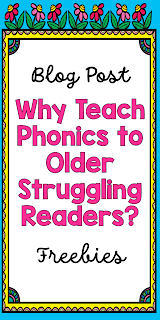Why Teach Phonics to Older Struggling Readers?
Phonological Awareness is Essential to Help Struggling Readers
Phonological awareness difficulties are the most common source of word-level reading difficulty (Hulme, Bowyer-Crane, Carroll, Duff, and Snowling, 2012; Melby-Lervag, Hulme, and Lyster 2012; Vellutino et al., 2004); however, phonological awareness is essential for skilled reading. 
Get this Resource here.
While most children develop this skill naturally, some weak readers will have little progress learning to read without phonological awareness training (Liberman & Liberman, 1990). Additionally, phonemic awareness is needed for efficient sight-word learning (Dixon et al., 2002; Ehri, 2005; Laing & Helme, 1999).
Phoneme segmentation is of the least sensitive phonological awareness tasks and, after first grade, is not a good indicator of the degree of phonemic proficiency need for skilled reading (Kilpatrick, 2012; Swank & Catts 1994). Highly successful intervention involves eliminating the phonological awareness difficulties in weak readers, but how? Thirty years of research indicates orthographic mapping holds the key.
In orthographic mapping of a word, the letters we see and the sounds we hear in that word get processed together as a sight word, then they are stored together in the brain. This is not the same as memorizing how a word looks. Rather, orthographic mapping is a mental process used to store and instantly remember words. It is not a skill, teaching technique, or activity you can do with students (Kilpatrick, 2019). What can be taught are phonemic awareness and phonics skills which enable orthographic mapping.
When children are learning to read, they first start by sounding out each individual sound within a word - this helps build their sight word vocabularies. As they read more, children start to recognize patterns because certain sounds appear over and over again in words. Eventually, they begin to recognize these patterns without having to sound them out every time.
For example, students read the word "can" so many times that when they come across "pan" and "man" and can read the –an part quickly because it has been orthographically mapped. According to David Kilpatrick, Ph.D., author of Equipped for Reading Success, with explicit instruction of phoneme-grapheme relationships (e.g., letter/sound correspondence), children can begin to read new “pseudowords” as accurate as 30% of the time by the end of second grade and 100% accuracy by the end of third grade (page 65-66). When this doesn't happen intervention is orthographic mapping is essential.
The resources listed below help students overcome orthographic mapping difficulties by:
- Helping eliminate phonological awareness deficits by teaching phonemic awareness to the advanced level without resources appearing or seeming young or babyish.
- Teaching and reinforcing phonics skills and phonic decoding.
- Providing authentic reading - that is reading connected to real text.






Comments
Post a Comment